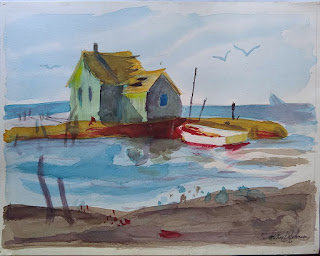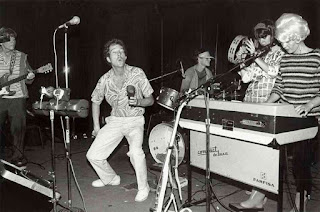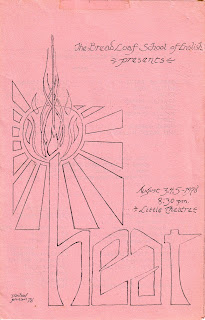(Looking for the post on Questions About the Advanced Plein Air Workshops? Click here.)
(Looking for the post on Questions About One-on-One Private Painting Intensive? Click here.)
I often get questions about my plein air painting workshops. As much as I love to answer individual e-mails, I thought I'd answer some of the more common ones here. Because I teach three different types of workshops, I'll split them across three blog posts.
But first, let me outline the three workshop types:
Now, on to questions about the all-level workshop. (By the way, if you have a question that's not answered here, please let me know and I'll be happy to add it.)
How do I know I'm ready for this workshop?
First, since you're reading this post, I assume you're already interested in plein air painting. A desire to learn is essential. But besides that, you must have some very basic painting skills. It's hard to learn how to paint and how to do it outdoors at the same time! Painting outdoors adds to the problems you encounter in the studio. So, if you haven't painted yet, do yourself a favor and take a beginner-level painting class in the studio. Learn how to hold a brush, how to prepare the canvas, and how to mix the basic colors. If you're a pastel painter, make sure you learn the different ways you can hold a pastel stick and know the basic colors you need for success. Also important is learning to find a set of materials that is right for you. (For example, not every oil painter likes canvas; you may discover that you have more success with gessoed hardboard. Or, if you're a pastel painter, perhaps a traditional pastel paper like Canson Mi-Teintes works better for you than UArt sanded paper.)
Basically, if you have reached a point in the studio where you are comfortable with your materials and process, you are ready to learn to paint outdoors.
Exactly what will be covered in this workshop?
In this workshop, I cover plein air painting essentials: gear, materials, how to handle the time factor, plus simplifying what we see. Time permitting, I also address value, design and color.
What kind of easel do I need?
You need an outdoor easel—studio easels are too cumbersome. I use a tripod (ProMaster XC525) to hold my paint or pastel box. For oil, I use the Prolific Painter "Daytripper" model plus the 18" Upright Panel Holder. For pastel, I use the Heilman Designs "Backpack" pastel box plus the optional easel attachment. There are many other brands on the market for pastel or oil. Keep in mind that you get what you pay for—don't skimp. But whatever you get, make certain that the setup is stable and won't shake when you paint. If you use a tripod, make sure that the tripod has a metal head, not a plastic one. Plastic heads can never be tightened enough to eliminate the shake.
Another brand I like to use with a good tripod when painting in oil: The Guerrilla Painter 9x12 pochade box. Unlike the "Daytripper," which is not a pochade box and will not allow you to transport wet panels, the Guerrilla Painter box is a true pochade, and will hold four panels in the lid, as well as paint tubes, etc., in the bottom. With the "Daytripper," I use a Panelpak to transport my wet panels.
What do I need to bring for supplies?
I have a full supply list for oil and pastel on my web site. Please bring everything on the list. If you need to substitute an item with something you already have (e.g. cadmium yellow rather than hansa yellow), ask me and I'll tell if you it will work or not. Finally, pay special attention to the items that are specific to plein air painting.
I'm flying. How do I take my paints?
Oil painters, pack your paints in a non-crushable container (a large plastic container works), insert a copy of the MSDS (Manufacturer's Safety Data Sheet) in with the paints, and label the container "Artist's Oil Colors—Made with Vegetable Oil—Non-Flammable." Tape the lid on securely. Put this in your checked baggage. Do not take mineral spirits or turpentine on the plane! Arrange to ship this to your destination or locate a local art supply store where you can get it. Other items, such as brushes, easel, etc., you can either put in the checked bag or carry-on. Pastel painters, do NOT put your pastels in your checked baggage. Pastels are "carry-on only," and make sure you are present when the TSA officer opens your bag so you can give him direction in opening the bag. (I have a blog post with more detail here.)
How will I get my paintings home?
Pastel painters, just sandwich your paintings between two sheets of foam board, and interleave the paintings with glassine. Tape up this sandwich so nothing shifts. Oil painters, I recommend Handy Porters, resuable cardboard boxes that can hold up to four wet panels or two wet canvases. The boxes come in different sizes. When heading home, these can either be packed inside a second box and shipped home, or you can carry them on the plane. On the other hand, if the paintings are dry to the touch when you're ready to leave, you can simply stack them and interleave them with waxed paper and make a sandwich, similar to what I recommend for pastel painters.
How should I prepare for the workshop?
If you haven't painted outdoors before, give it a try. This will give you a leg up on the learning process. Also, I recommend that you enroll in my Plein Air Essentials self-study, self-paced online course and read my book, Backpacker Painting: Outdoors with Oil and Pastel. I also have several videos through Northlight Shop.
Will I need to walk far?
But first, let me outline the three workshop types:
- The all-level workshop. This is for any level of painter but especially for those who are new to plein air painting. I do, however, expect the student to know the very basics of painting. This is not a workshop for someone who has never painted before. In this workshop, I cover plein air painting essentials: gear, materials, how to handle the time factor, plus simplifying what we see. Time permitting, I also address value, design and color.
- The advanced workshop. This is for painters who have painted outdoors but who would like to learn the finer points that I don't have time to address in the all-level workshop. In this workshop, I cover different color palettes for the landscape; how to see and capture color temperature; how to manage edges and brush work; and understanding what makes a good painting.
- The one-on-one private painting intensive. This is for experienced outdoor painters who want to bring their craft to the next level. Completely customized to the student after a consultation, the program can also include business help and mentoring.
Now, on to questions about the all-level workshop. (By the way, if you have a question that's not answered here, please let me know and I'll be happy to add it.)
How do I know I'm ready for this workshop?
First, since you're reading this post, I assume you're already interested in plein air painting. A desire to learn is essential. But besides that, you must have some very basic painting skills. It's hard to learn how to paint and how to do it outdoors at the same time! Painting outdoors adds to the problems you encounter in the studio. So, if you haven't painted yet, do yourself a favor and take a beginner-level painting class in the studio. Learn how to hold a brush, how to prepare the canvas, and how to mix the basic colors. If you're a pastel painter, make sure you learn the different ways you can hold a pastel stick and know the basic colors you need for success. Also important is learning to find a set of materials that is right for you. (For example, not every oil painter likes canvas; you may discover that you have more success with gessoed hardboard. Or, if you're a pastel painter, perhaps a traditional pastel paper like Canson Mi-Teintes works better for you than UArt sanded paper.)
Basically, if you have reached a point in the studio where you are comfortable with your materials and process, you are ready to learn to paint outdoors.
Exactly what will be covered in this workshop?
In this workshop, I cover plein air painting essentials: gear, materials, how to handle the time factor, plus simplifying what we see. Time permitting, I also address value, design and color.
What kind of easel do I need?
You need an outdoor easel—studio easels are too cumbersome. I use a tripod (ProMaster XC525) to hold my paint or pastel box. For oil, I use the Prolific Painter "Daytripper" model plus the 18" Upright Panel Holder. For pastel, I use the Heilman Designs "Backpack" pastel box plus the optional easel attachment. There are many other brands on the market for pastel or oil. Keep in mind that you get what you pay for—don't skimp. But whatever you get, make certain that the setup is stable and won't shake when you paint. If you use a tripod, make sure that the tripod has a metal head, not a plastic one. Plastic heads can never be tightened enough to eliminate the shake.
Another brand I like to use with a good tripod when painting in oil: The Guerrilla Painter 9x12 pochade box. Unlike the "Daytripper," which is not a pochade box and will not allow you to transport wet panels, the Guerrilla Painter box is a true pochade, and will hold four panels in the lid, as well as paint tubes, etc., in the bottom. With the "Daytripper," I use a Panelpak to transport my wet panels.
What do I need to bring for supplies?
I have a full supply list for oil and pastel on my web site. Please bring everything on the list. If you need to substitute an item with something you already have (e.g. cadmium yellow rather than hansa yellow), ask me and I'll tell if you it will work or not. Finally, pay special attention to the items that are specific to plein air painting.
I'm flying. How do I take my paints?
Oil painters, pack your paints in a non-crushable container (a large plastic container works), insert a copy of the MSDS (Manufacturer's Safety Data Sheet) in with the paints, and label the container "Artist's Oil Colors—Made with Vegetable Oil—Non-Flammable." Tape the lid on securely. Put this in your checked baggage. Do not take mineral spirits or turpentine on the plane! Arrange to ship this to your destination or locate a local art supply store where you can get it. Other items, such as brushes, easel, etc., you can either put in the checked bag or carry-on. Pastel painters, do NOT put your pastels in your checked baggage. Pastels are "carry-on only," and make sure you are present when the TSA officer opens your bag so you can give him direction in opening the bag. (I have a blog post with more detail here.)
How will I get my paintings home?
Pastel painters, just sandwich your paintings between two sheets of foam board, and interleave the paintings with glassine. Tape up this sandwich so nothing shifts. Oil painters, I recommend Handy Porters, resuable cardboard boxes that can hold up to four wet panels or two wet canvases. The boxes come in different sizes. When heading home, these can either be packed inside a second box and shipped home, or you can carry them on the plane. On the other hand, if the paintings are dry to the touch when you're ready to leave, you can simply stack them and interleave them with waxed paper and make a sandwich, similar to what I recommend for pastel painters.
How should I prepare for the workshop?
If you haven't painted outdoors before, give it a try. This will give you a leg up on the learning process. Also, I recommend that you enroll in my Plein Air Essentials self-study, self-paced online course and read my book, Backpacker Painting: Outdoors with Oil and Pastel. I also have several videos through Northlight Shop.
Will I need to walk far?
We will paint at the most a few minutes from the car. However, I do recommend that you wear good walking shoes. If you have mobility issues, please understand that you will need to carry your own gear unless you bring an assistant.
Can I bring my spouse or friend? My dog?
Most of our locations will having hiking and photography opportunities. If your spouse or friend likes to hike or take photos, they are more than welcome to join us on-location. In the studio, when we are doing critiques and lectures, they are welcome to join us if there is adequate seating and they sit quietly in the back. Unfortunately, dogs are not allowed in the studio or to be with you while we work on-location.
In my next post, I'll talk about the advanced plein air painting workshops. In the meantime, if you're interested in taking a workshop with me, please see the following for my schedules:
Paint the Southwest (all-level workshops): www.PaintTheSouthwest.com/sched_reg.htm
Paint the Southwest (one-on-one private painting intensive for experienced painters): www.PaintTheSouthwest.com/sched_int.htm
Plein Air Painting Maine (all-level and advanced workshops in Maine): www.PleinAirPaintingMaine.com
General Workshop Listing (which includes workshops for art centers): www.MChesleyJohnson.com/workshops
Can I bring my spouse or friend? My dog?
Most of our locations will having hiking and photography opportunities. If your spouse or friend likes to hike or take photos, they are more than welcome to join us on-location. In the studio, when we are doing critiques and lectures, they are welcome to join us if there is adequate seating and they sit quietly in the back. Unfortunately, dogs are not allowed in the studio or to be with you while we work on-location.
In my next post, I'll talk about the advanced plein air painting workshops. In the meantime, if you're interested in taking a workshop with me, please see the following for my schedules:
Paint the Southwest (all-level workshops): www.PaintTheSouthwest.com/sched_reg.htm
Paint the Southwest (one-on-one private painting intensive for experienced painters): www.PaintTheSouthwest.com/sched_int.htm
Plein Air Painting Maine (all-level and advanced workshops in Maine): www.PleinAirPaintingMaine.com
General Workshop Listing (which includes workshops for art centers): www.MChesleyJohnson.com/workshops
 |
| Lecture time in the studio for the all-level plein air painting workshop |

















































